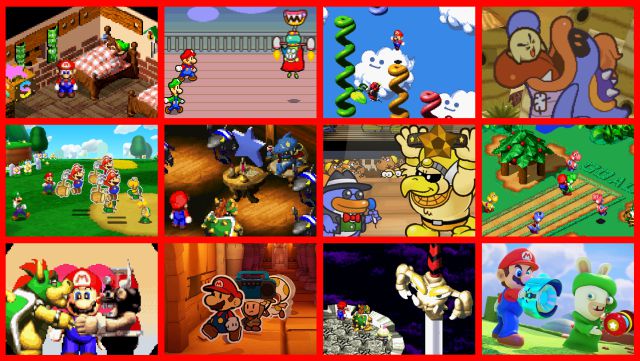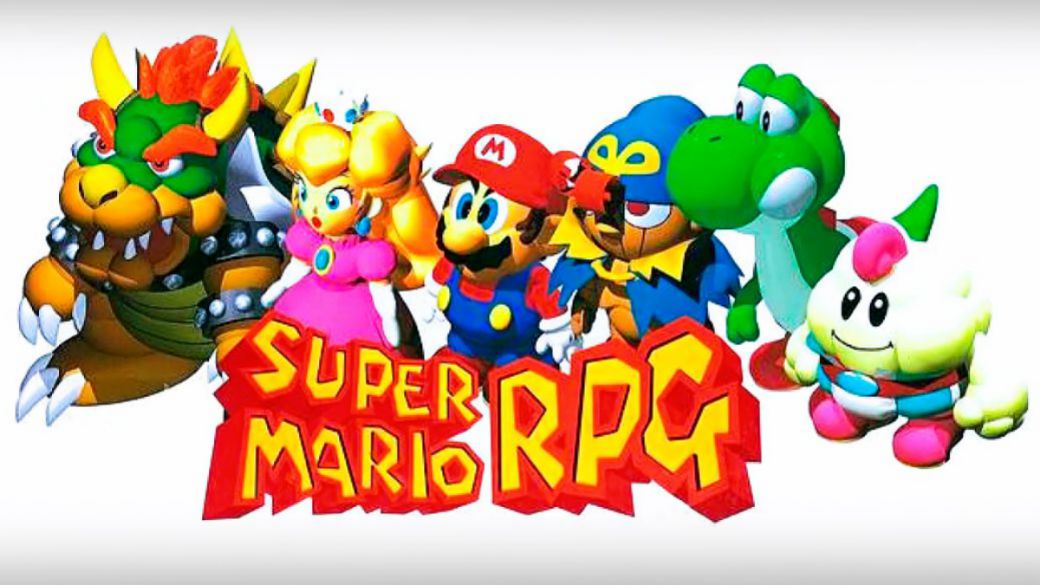
We review how the alliance between Nintendo and Square was forged, the gestation of Legend of the Seven Stars and its influence on Paper Mario and Mario and Luigi.
Not even two weeks have passed since we celebrated the 25th anniversary of Secret of Evermore in Europe and today we have to remember another event also related to Super Nintendo, although of a more general nature. First, because Super Mario RPG: Legend of the Seven Stars did not reach our continent —at least not until 2008, when Nintendo recovered it for the Wii Virtual Console—; and second, because beyond its unquestionable qualities as an individual work, the title also marked Mario’s first foray into the role, a rather surprising decision in its day, but destined to germinate in one of the most beloved spin-off branches. of the saga.
Of course, things were not entirely simple and Super Mario RPG, as many of you already know, never received a formal sequel due to the problems between Nintendo and Squaresoft – an issue that we will also discuss. But that does not prevent his legacy from reaching, directly or indirectly, to this day: the Paper Mario from Intelligent Systems, the Mario & Luigi from AlphaDream or even the recent Mario + Rabbids from Ubisoft are debtors of that unusual SNES game, still remembered as a unique event – and included, of course, in the selection of SNES Mini. So let’s take a closer look at how the stars aligned to favor this historic collaboration.

Internationalizing the Japanese role
Like so many good stories about video games, the Super Mario RPG dates back to the eighties, a decade in which Squaresoft began to distinguish itself as one of the main developers of JRPG and Nintendo established itself as the dominant hardware producer in the console market. Despite their independence, both companies prospered hand in hand and Square – during its first years limited to the Japanese market – began to launch some NES games in America or even Europe in the case of Rad Racer, a racing title designed by Hironobu Sakaguchi. . The same Sakaguchi who in 1987 would create Final Fantasy and propel Square towards a new era of success marked by his specialization in that genre.
The arrival of the nineties and the SNES established the company, which went from hit to hit in its homeland. Although Enix’s Dragon Quest remained as the queen saga, Final Fantasy IV, V and VI traced an upward trajectory (from almost a million and a half copies sold of the first to more than two and a half million of the third) and names like Secret of Mana or the Romancing SaGa series had no problem becoming “million-sellers” either. Outside of Japan, however, the story was somewhat different. Square continued to liven up with some locations, but the results were far from being that good, which led to decisions such as not adapting Final Fantasy V or the Romancig SaGa, and creating games like the simpler Mystic Quest Legend or the American Secret of Evermore to appeal to the western market.

It was a problem that Nintendo did not have. Many of its sagas worked well in all territories, and Mario in particular had risen as a safe value, so among the platform deliveries it did not take long for spin-offs such as educational games to appear – officially licensed, but without Nintendo involvement. , Dr. Mario, NES Open Tournament Golf, Mario Paint or Super Mario Kart, the plumber’s first great explosion outside his natural genre (surpassing 8 million global copies and climbing to the top 5 of SNES). Therefore, by the mid-nineties, it was almost inevitable that the paths of both companies would cross: Square still needed an extra push outside of Japan and Shigeru Miyamoto (creator of Mario) was also interested in making an RPG with the mascot.
Collision of worlds
The first step was taken by Square, who approached Nintendo in early 1994 to propose the project. After making sure they were on the same page, Nintendo agreed, and development was handled by an internal Squaresoft studio that had regular meetings with Miyamoto. The creative, at the time still months away from starting work on the legendary Super Mario 64, acted as a supervisor to ensure that the game aligned with what users expected of Mario despite the genre change. One of his requests, in fact, was not to use traditional weapons such as swords, which led to complement basic actions such as jumping with a hammer like the one he had already wielded in his origins, when he was a carpenter and responded to the name of Jumpman in the Arcade Donkey Kong.
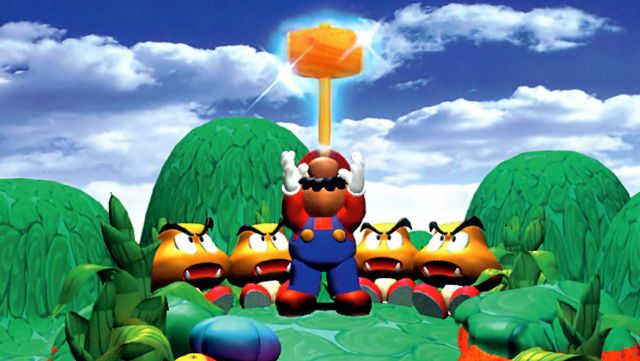
Kensuke Tanabe, currently best known for acting as a bridge between Nintendo and Western studios such as Retro Studios or Next Level Games, was also in charge of supervising the script, and since Square had plenty of its own licenses to carry out (the development coincided with that of Chrono Trigger, Seiken Densetsu 3 and Romancing SaGa 3, among others), two new directors were assigned to the project: Chihiro Fujioka and Yoshihiko Maekawa. The first had already written for Mystic Quest Legend, a previous attempt to internationalize the JRPGs, while the second came from participating in the recently completed Final Fantasy VI – many members of that team were divided between Chrono Trigger and Mario RPG, leaving Final Fantasy VII temporarily paused. Another name worth mentioning was Taro Kudo, a designer who years later would participate with Intelligent Systems in the direction of Sticker Star and Color Splash (in addition to writing the delusional The Origami King of Switch).
A game little known here for lacking localization even today, Live a Live, also completed development in 1994 and yielded several key figures. Maekawa and several programmers had participated in it, but more symbolic was the incorporation of Yoko Shimomura, a composer who shortly before had made the leap from Capcom to Square. By then, Shimomura had already made a name for himself thanks to the Street Fighter II soundtrack, but his interest in composing for role-playing games, richer in the variety of situations and emotions, motivated him to change company and found in Legend of Seven Stars his first great RPG, the definitive step to consecrate himself in the genre and open the doors of names such as Parasite Eve, Kingdom Hearts, Xenoblade Chronicles or Final Fantasy – in addition, of course, Mario & Luigi.
A fun RPG to drive
Looking at the finished game now, 25 years from the future, the way in which all its pieces fit together seems easy, but getting there was a laborious process and full of doubts. Square’s specialty was top view games, but Mario required special treatment, not making a Final Fantasy mod. The inspiration ended up coming from quite a distance, from another continent, seeing the excellent results that Rare was achieving with Silicon Graphics computers, creating and converting 3D models into three-dimensional-albeit technically 2D-looking sprites suitable for use on the SNES. Sure, spectacular as they were, games like Donkey Kong Country or Killer Instinct were sticking to side scrolling, but an RPG with towns, forests, and dungeons required freer movement to explore.
That need led to the isometric view, and also to a new complication because another of Miyamoto’s guidelines was to make the gameplay direct and fun, while preserving a platform component in the handling and design. Therefore, before the Nintendo studios had the specifications of the mysterious Ultra 64, in Square they were already creating characters and polygonal objects with the responsibility of making them fit well into the Mario universe both on a visual and tactile level, implementing and polishing an octagonal control system versus the four basic directions of other isometric games. It was a process that took months, but little by little it became a satisfactory experience, even causing Miyamoto to consider creating Super Mario 64 in his wake – an idea that he would later discard to prioritize free control over the camera.
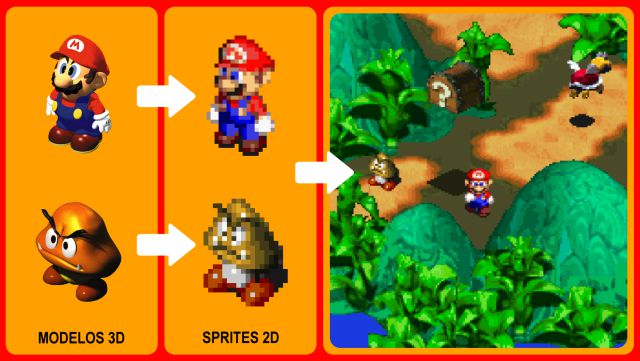
This control married well with the idea of having enemies prowling the areas, easy to avoid if we did not want to enter combat, but strategically placed to cross our path or intercept us under block chests or other platform challenges towards optional objects. Super Mario RPG posed the scenarios more like courses with obstacles than as strictly natural environments: rotating flowers served to propel us towards elevations if we jumped at the right time; floating panels activated and moved when stepped on by Mario; And that’s without getting into the occasional minigames like Yoshi racing, barrel descents downstream, a wagon circuit that temporarily swapped the isometric view for Super Mario Kart Mode 7, etc.
Varied and well-executed distractions, although they did not deprive combat of its importance as a central playable component. The designers kept the turns pure of other RPGs, but rethought the interface so that each front button served to access and activate different types of commands. Thus, button A made us enter the attack menu and executed them, but button B was not used to cancel and go back, but to directly enter the defense and retreat menu, while the items and special techniques were used. assigned to the X and Y buttons respectively. All this, in addition, color-coded in the Japanese version (red, yellow, blue and green), although in America the SNES controller only used two shades of purple and the interface lost that extra distinction.
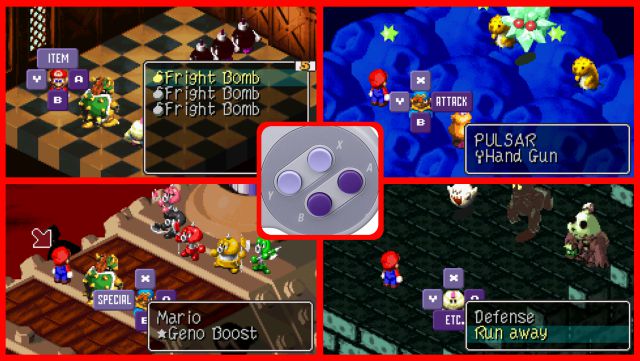
Three is company, five is crowd
Overwriting the instinct to use the crosshair to switch between menus might take some practice, but it soon made the process more streamlined. Additionally, the use of A to attack or Y to deploy special techniques could be repeated moments later, just before hitting enemies, to increase their effectiveness. These bonuses, called timed hits, had different action windows depending on the attack, and in the case of some special techniques, they were sometimes replaced by more specific instructions such as repeatedly pressing the button, letting a meter load with stars, or rotate with quickly the control cross. Not forgetting, of course, the existence of defensive bonuses, applicable if we also pressed the buttons at the right time, before receiving the attacks.
At a strategic level, Super Mario RPG was not particularly complex or difficult, but the fast pace of combat and that degree of participation beyond choosing the commands kept the fights very active despite the turns. On the other hand, although limited to a maximum team of three, the roster rose to five characters once Bowser and Peach (then Toadstool) joined the adventure. In an interesting and successful twist – since the opening bars implied that the story was once again focused on rescuing the princess – including them as playable characters offered more flexibility as a team, since they all had their own techniques and advantages. (Bowser, for example, excelled at brute force, while Peach was great for healing and altered states.)
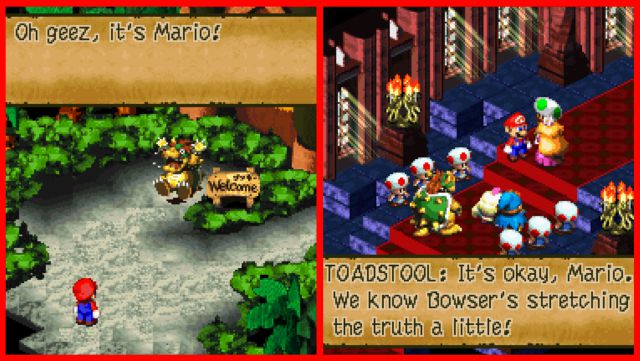
An atypical detail is that, although they all had their own statistics – with attribute bonuses to choose from at each level up – weapons and equipment, the flower points needed to perform special techniques were accumulated in a common pool (if we had 10 SP and Mario used a 3 SP attack, the next character would have 7 SP left). An attempt perhaps to reinforce the camaraderie present in the narrative: in terms of the plot, Super Mario RPG was straightforward and quite predictable – at least since Peach joined the group – but the characters elevated the story thanks to their interactions: Mario lacked dialogue, although he related his chronicles with the skill of a professional mime; Bowser and Peach defined themselves better than ever before and many times after (the former was able to show their vulnerabilities, the latter their strengths); and both Mallow —the cloud that was believed to be a tadpole— and Geno —the doll controlled by a celestial entity— also loved each other despite being their first and only adventure.
The script was surprisingly inspired, combining the usual innocence and sucrose with pangs of sharp humor and plenty of surreal situations. In the absence of formal kidnapping by Bowser, for example, this time the princess fell into the fortress of Booster, a flamboyant hermit with no social skills who proceeded to organize a wedding simply to eat cake. And the discovery of Mallow’s true identity as prince of a kingdom in the clouds was succeeded by the infiltration of a palace occupied by Valentina, a gold digger who had led everyone to believe that Mallow himself was a plump black bird to whom she was engaged. Legend of the Seven Stars didn’t have the dramas and machinations of other JRPGs, but it did have a concatenation of characters and memorable moments punctuated by Shimomura’s excellent soundtrack.
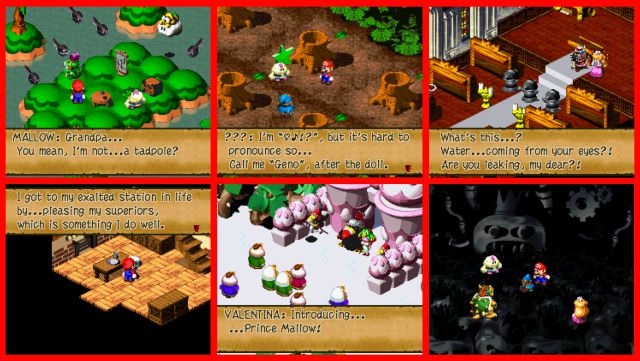
the end of an era
On March 9, 1996, Super Mario RPG was released in Japan. Then there were just over three months until the launch of Nintendo 64 and Super Mario 64 monopolized the lists of most anticipated games, but that did not detract from the appeal of Squaresoft’s work, which was acclaimed and touched one and a half million copies sold. In America they had to wait until May and, although it still did not reach those kinds of figures, it exceeded 600 thousand copies, becoming the most successful 16-bit JRPG of the company in the West despite not reaching Europe – questionable decision made to save extra localization costs in the fall of SNES. This, coupled with the also very positive critical reception, under normal conditions would suggest that Super Mario RPG 2 was a safe bet, but nothing could be further from the truth.
Because in parallel, after the short break in 1994, Square had resumed production of Final Fantasy VII and found itself faced with the dilemma of continuing with Nintendo, which required adapting to the space limitations of the cartridge and the more demanding architecture of Nintendo 64. , or go to Sony’s PlayStation, where programming was simpler and CDs allowed hundreds of megabytes of music and video to be put in. Now we know well how that story continued and it’s hard to remember the time when Square and Nintendo always went hand in hand; But in early 1996, when the change was made public, the shock was considerable and caused a total rift between the two companies. Neither Final Fantasy VII nor any other Square game would see the light of day on a Nintendo console for quite a few years.

Life without Square
Mallow and Geno – in addition to the other unreleased characters created by the studio – were left out of the reach of Nintendo, although obviously not Mario, nor the concept of embarking him on an RPG adventure, so the decision was soon made to commission the sequel to Intelligent Systems. It was its own and prolific studio, which in recent years had stood out above all for Fire Emblem, a tactical role-playing saga still not adapted to the West, but with proven success in Japan. The team went to work immediately and in the Space World of 1997, Super Mario RPG 2 already appeared between games like Ocarina of Time or a Conker very far from what years later would be Bad Fur Day. At that time, Mario RPG 2 was announced as one of the projects that would take advantage of the 64DD (peripheral with higher capacity floppy disks), but neither that, nor the name, remained, because the game evolved into what we know today like Paper Mario.
Despite being titled Mario Story in Japan, the Western name better reflected the shift in visual style from emulating 2D three-dimensionality to dropping flat characters onto 3D worlds. On the other hand, now Mario was the only protagonist, but he could be much more personalized by equipping medals and he was joined by seven companions with their own stories and abilities to rotate. Something that remained was the structural resource of searching for seven stars – this time to rescue Peach from Bowser ‘s clutches, oops – and the combat system with timed hits, reformulated with clearer and more varied action indicators. Upon his arrival in 2000 (2001 in the West), he was also acclaimed by the press and the public, although given the difficult situation of Nintendo 64, not even the European location helped him to reach the figures of his predecessor. Even so, it achieved good results (1.37 million global copies reported) and ensured the continuity of the new series.

Precisely in 2000 another key event for the legacy of Super Mario RPG also took place, and it was the formation of AlphaDream. Or rather, from AlphaStar, the name that the studio founded by Tetsuo Mizuno initially received. Although his name has not appeared until now, this executive was none other than the former president of Squaresoft, a job he had carried out between 1991 and 1996 – the entire SNES cycle. After leaving in 1998, Mizuno decided to create his own company along with other Square employees, among whom, curiously, were the two directors of Super Mario RPG: Chihiro Fujioka and Yoshihiko Maekawa. By then, Nintendo had already covered the ballot with Paper Mario on the desktop, but the imminent arrival of the Game Boy Advance offered a new opportunity to reimagine a 16-bit Mario RPG. So another collaboration was hatched.
Released in late 2003, Mario & Luigi: Superstar Saga (Mario & Luigi RPG in Japan) opted for more traditional sprites than Super Mario RPG, featured Luigi as a co-star, and continued to prioritize humor over elaborate storylines. . The animation work was stellar, easily the best yet; and the combat, while limited to Mario and Luigi, was recast from the ground up with loads of microgames to deploy attacks – often double ones – using, in addition, the A and B buttons to give them separate instructions on and off the buttons. fights. Even Yoko Shimomura, newly independent from Square, returned to compose the soundtrack, reinforcing that feeling of going back to the old days. The result was a great game with great success: the more than 2 million copies sold this time did put it next to Super Mario RPG and showed that there was room for two alternative role-playing series.
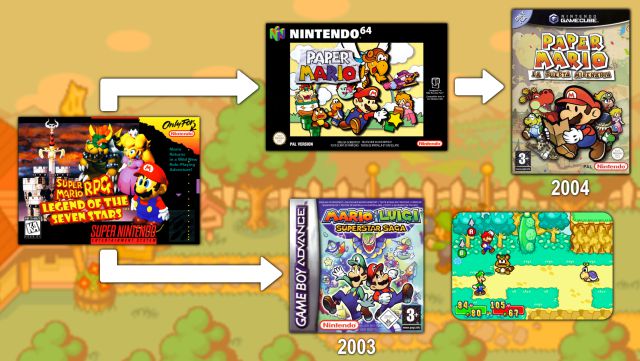
Flying close to the sun
Less than a year later, The Millennial Door arrived on the GameCube and, although it was once again not the most suitable console to succeed, it surpassed the first Paper Mario both in sales (close to two million) and in creativity. Although at this time Nintendo and Square had already made peace (Final Fantasy was still a brand associated with Sony, but in 2003 GBA received FF Tactics Advance and GameCube, Crystal Chronicles), Super Mario RPG 2 continued without materializing because there was hardly any need. Nintendo had found relief twice, and fans were responding. Unfortunately, it would be a splendor with an expiration date.
AlphaDream began working non-stop on Mario & Luigi, releasing two installments on Nintendo DS and another two on 3DS (one in the form of a crossover with Paper Mario). Things were going well and Bowser’s Journey to the Center – second installment of DS – rose to the current record of the Marios RPG to rise above four and a half million copies sold. Perhaps that was what led to a certain overconfidence and the unreleased 3DS games being succeeded by two remakes (of Superstar Saga and Bowser’s Journey to the Center). None were unwelcome, but they accentuated a downward trajectory that culminated in AlphaDream’s bankruptcy in 2019. The license as such belongs to Nintendo and was renewed last year, so it may return in the future, but for now that is the sad end of its story.

The story of Paper Mario is more complicated if possible, but also better known because it has been the subject of countless debates and articles: after The Millennial Door, Intelligent Systems embarked on a constant crusade to reinvent the series at the cost of moving away from the role-playing roots. Super Paper Mario – to date, the best-selling Paper with also more than four million copies – rejected the shifts and went to the top of the platform, while Sticker Star and Color Splash (directed by another Super Mario RPG veteran, Taro Kudo) incorporated a system with single-use stickers / cards in turn-based battles, but without leveling up. Last year, The Origami King returned to give his own twist to the fights, rethought as puzzles where we must rotate the ground to align enemies and maximize the effectiveness of the attacks, although still without experience points or the degree of customization that allowed the first two Paper.
Of course, a constant in both Super and Color Splash and Origami King – except in the case of Sticker Star – has been the humor, the crazy characters and the variety of situations in which we find ourselves involved. It is what defines Mario “role-player” today, beyond the mechanics and systems. Ubisoft and its Mario + Rabbids have also managed to recapture that essence by taking it to the field of the tactical role, in another success that can become a new series if both companies lend themselves to it (the last figure, offered in 2018, already placed it by over two million copies). Today, it is difficult to know what the future holds for this strand of spin-offs. The continuity of Paper Mario seems assured (Origami is the second best seller after Super) and its creators do not rule out returning to a more traditional role. But for now there is no other choice but to wait, celebrate 25 years of Super Mario RPG and remember the countless moments that he and his successors have left us.
